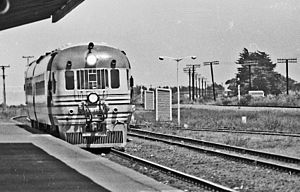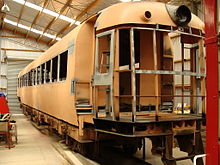- NZR RM class (88 seater)
-
NZR RM class
Articulated 88-seater
Blue Streak 88-seater RM 125 at Feilding in 1974In service 1955 - 1978 Manufacturer Drewry Car Co, England Built at Birmingham Railway Carriage & Wagon Co, Smethwick, UK Entered service 1955 - 1958 Scrapped 1978 Number built 35 Number in service 0 Number scrapped 34 Formation No 1 end (36 passengers & luggage compartment) articulated over a Jacobs bogie with No 2 end (52 passengers) Fleet numbers RM 100 - RM 134 Capacity 88 Operator New Zealand Railways Line(s) served various Specifications Car length 105 ft (32.0 m) total Width 8 ft 10 in (2.7 m) Maximum speed 65 mph (105 km/h) Weight 63.1 long tons (64.1 t) Engine(s) Two Fiat 700.040, six cylinder, horizontal underfloor, 1500 rpm naturally aspirated Power output 420 hp (310 kW) total (original)
370 hp (280 kW) (derated)Transmission Wilson 5-speed gearbox (per engine) Gauge 1,067 mm (3 ft 6 in) Cape gauge The NZR RM class 88-seaters were a class of railcar used in New Zealand, known unofficially as 'articulateds', 'twinsets', 'Drewrys' and 'Fiats'. They were purchased to replace steam-hauled provincial passenger trains and mixed trains. New Zealand Railways classed them RM, the notation used for all railcars, numbering the 35 sets from RM100 to RM134.
Contents
History
In the early 1950s, New Zealand Railways were in the process of replacing steam traction with diesel and modernising the railways to cope with vastly increased traffic, the after-effects of wartime stringency, and increasing competition from motor vehicles and aeroplanes. As part of this modernisation process, it was decided to upgrade provincial passenger services, which were provided by a combination of steam-hauled passenger trains that operated several times a week, and "mixed" trains that carried both freight and passengers. An order was placed with the Drewry Car Company in the United Kingdom, which had supplied some smaller diesel shunters previously. They presented a design for an articulated railcar with seating for 88 passengers. The use of horizontal diesel engines allowed increased passenger capacity and a large parcels/baggage compartment. Fiat 210 hp units were selected. The 88-seaters were constructed by the Birmingham Railway, Carriage and Wagon Company Ltd under contract from Drewry.
After initial trials around Wellington, the 88-seaters were deployed on a wide variety of provincial services. In the North Island they ran Auckland - Okaihau, Auckland - Te Puke, Auckland - Rotorua, Auckland - New Plymouth, Wellington - Palmerston North via Masterton, and Wellington - Gisborne. In the South Island they ran Christchurch - Picton, Christchurch - Invercargill, and in conjunction with the Vulcan class, Christchurch - Greymouth and Ross.
Operation
From almost the beginning they faced mechanical problems, with cooling being the primary issue. The engines had been designed for Italian naval boats and were unsuitable for the conditions. Although modifications were made they continued to have a reputation for unreliability throughout their career, frequently having to run with one motor isolated.
Unfortunately for NZR, the 1950s was a period of increased prosperity and saw massive increases in the numbers of private motorcars, along with improvements to roading such as tarsealing the main highways, and construction of the Auckland Harbour Bridge. These meant dramatic falls in passenger numbers, and in 1967-68 all railcar services from Auckland were cut except for the service to New Plymouth. This was cut back to operate between New Plymouth and Taumarunui in the early 1970s, with passengers making connections to North Island Main Trunk trains. All cancelled trains were replaced by New Zealand Railways Road Services buses.
Although the remaining services were to areas not well served by road, the mechanical condition of the 88-seaters meant that by the mid 1970s replacement was becoming urgent. It was decided to refurbish 14 of them, remove their engines and drivers' cabs, and convert them to what was known as AC class unpowered carriages. These were painted green and came to be known as 'grassgrubs'. They ran on the New Plymouth to Taumarunui, a newly reintroduced Napier to Gisborne service, Wellington to Palmerston North via the Wairarapa, Picton to Christchurch, and Christchurch to Greymouth services. The final run of an 88-seater railcar was in 1978 from Greymouth to Christchurch. The last trip came to an ignominious end when an engine failure and fire meant that passengers had to be taken onwards from Otira by bus.
The 'grassgrubs' were ill-fated. Their drawgear and bodies were not designed to be locomotive-hauled and they quickly wore out. By 1985 they had been withdrawn from service due to metal fatigue. Most of the passenger runs were continued after their demise, but the New Plymouth-Taumarunui service ended in 1983 (having already had its rolling stock replaced by 56 ft cars), and by the late 1980s the Wellington-Wairarapa service was abbreviated to terminate in Masterton as patronage on the Masterton - Palmerston North section was often fewer than 20 passengers per trip, due to improved highways and bus services. The AC class vehicles were replaced by NZR 56-foot carriages on the remaining Wellington-Napier, Picton-Christchurch, Wairarapa and Christchurch-Greymouth services.
Blue Streaks
In 1968, at the suggestion of Hamilton City Council, an 88-seater was refurbished for a new fast service between Hamilton and Auckland aimed at the businessman, and it started on Monday, 8 April 1968. It was fitted with carpet and reupholstered fabric-covered seats, and was painted in a new two-tone colour scheme that prompted the nickname 'Blue Streak'. The seating was reduced to 84 to accommodate a servery area from which light meals and assorted alcoholic and non-alcoholic drinks could be purchased. This initial service was unsuccessful, with patronage well below levels needed to be profitable.
It was decided to introduce the railcar to a daytime service between Auckland and Wellington in conjunction with the Scenic Daylight carriage train. This service, which started on Monday 23 September 1968, was highly successful and prompted the conversion of two further cars to 82 seats each to accommodate larger servery areas and, later, the purchase of the dedicated Silver Fern railcars for this service.
Initially, the Blue Streak railcar ran from Wellington to Auckland on Mondays, Wednesdays and Fridays and on Tuesdays and Thursdays from Auckland to Wellington until a second railcar was refurbished for the Christmas 1968-New Year 1969 period and a third for the 1969 Easter holidays. The service proved so popular that it was not uncommon to see two Blue Streaks running in multiple in one direction, with the third paired up with an unrefurbished red 88-seater in the other, and the Scenic Daylight carriage train ceased operating.
On Thursday 18 December 1972, the Blue Streaks were replaced by the new Silver Fern railcars and transferred to the Wellington to New Plymouth service, replacing Standard railcars. They continued on this service until Friday 30 July 1977. By that time they were no longer serviceable, patronage had continued to decline and the service was replaced with buses.
Long Distance Passenger Trains of New Zealand Operational North IslandSouth IslandHistoric North IslandBay Express • Blue Fern • Blue Streak • Daylight Limited • Endeavour • Geyserland Express • Kaimai Express • Napier Express • New Plymouth Express • New Plymouth Night Express • Night Limited • Northerner • Northland Express • Rotorua Express • Scenic Daylight • Silver Star • Silver Fern • Taneatua Express • Taranaki Flyer • Thames Express • Waikato Connection • Wairarapa MailSouth IslandPreservation
Following withdrawal from service a number of RM class were stored around the country. Several units along with Vulcan RMs were sold to the abortive Southern Rail preservation project at Christchurch where they were scrapped; the cab and baggage car section of the No.1 end of RM 119 on the leading bogie together with some engines and gearboxes were kept at this time. After the project was wound up, the partial section of RM 119 was moved to Linwood Locomotive Depot where it remained in storage for several years. Subsequently the further abbreviated RM 119 consisting of just the cab and part of the baggage compartment was stored in a Bromley scrapyard, where it was found and purchased by the RM 133 Trust.
By the early 1990s it appeared that an 88-seater would not be preserved. The only one believed still to be in existence was a 'grassgrub', former RM 133, used for fire training at Auckland Airport. Fortunately in 2001 the RM 133 Trust was able to obtain this car, with one end fire damaged. In addition both sections of RM 121 were located, the No.2 end being found and recovered from a quarry near Kerikeri. The No.1 end was located at Waitomo, being used as a motel unit, and has since been relocated to Pahiatua.[1] Restoration work has begun on the No.2 unit which has been welded back together, having been cut in two at some stage.
Class register
Key: In service Out of service Auckland Transport service Preserved Overhaul Scrapped Number Entered service Withdrawn Notes RM 100 March 1955 June 1983 Converted to AC carriage set RM 101 May 1955 December 1968 RM 102 September 1955 June 1985 Converted to AC carriage set RM 103 August 1955 June 1985 Converted to AC carriage set RM 104 June 1955 RM 105 July 1955 September 1978 RM 106 September 1955 November 1967 RM 107 November 1955 September 1983 Converted to AC carriage set RM 108 February 1956 May 1979 RM 109 February 1956 December 1971 RM 110 February 1956 April 1985 Converted to AC carriage set RM 111 February 1956 June 1985 Converted to AC carriage set RM 112 February 1956 April 1985 Converted to AC carriage set RM 113 February 1956 April 1980 RM 114 February 1956 April 1975 RM 115 February 1956 September 1978 RM 116 February 1956 December 1971 RM 117 March 1956 RM 118 March 1956 RM 119 April 1956 July 1980 Blue Streak railcar
No 1 end cab and part of luggage compartment still exists, and under ownership of RM 133 TrustRM 120 May 1958 RM 121 June 1956 September 1978 No 2 end is under restoration to become No 2 end of restored RM 133
No 1 end was being used as a motel unit in Waitomo, now at Pahiatua.[1]RM 122 June 1956 December 1971 RM 123 June 1956 August 1981 Blue Streak Railcar RM 124 July 1956 December 1971 RM 125 July 1956 RM 126 August 1956 December 1971 RM 127 August 1956 April 1985 Converted to AC carriage set RM 128 August 1956 December 1971 RM 129 September 1956 December 1971 RM 130 September 1956 December 1971 RM 131 October 1956 July 1980 Blue Streak Railcar RM 132 November 1956 September 1975 Destroyed by fire near Eketahuna on 24 August 1975. Written off and scrapped at Eketahuna in September 1975.[2] RM 133 December 1956 June 1984 Converted to AC carriage set
No 1 end being restored by RM 133 Trust
No 2 end damaged by fire beyond repairRM 134 July 1957 October 1982 Converted to AC carriage set External links
References
- ^ a b Eastwood, Tamara (1 September 2011). "Half railcar pulls up". Wairarapa Times Age (Masterton: APN Holdings NZ). http://www.times-age.co.nz/news/half-railcar-pulls-into-the-station/1088183/. Retrieved 2 September 2011.
- ^ Churchman, Geoffrey B (1992). Danger Ahead New Zealand Railway Accidents in the Modern Era. IPI Publishing Group. pp. 86. ISBN 0-908876-74-2.
- Heath, Eric, and Stott, Bob; Classic Railcars, Electric and Diesel Locomotives Of New Zealand, Grantham House, 1993
- Churchman, Geoffrey; The Golden Era of Fiat Railcars in New Zealand, IPL Publishing, 1989
Categories:- Locomotives of New Zealand
- Articulated passenger trains
- Fiat multiple units
Wikimedia Foundation. 2010.



